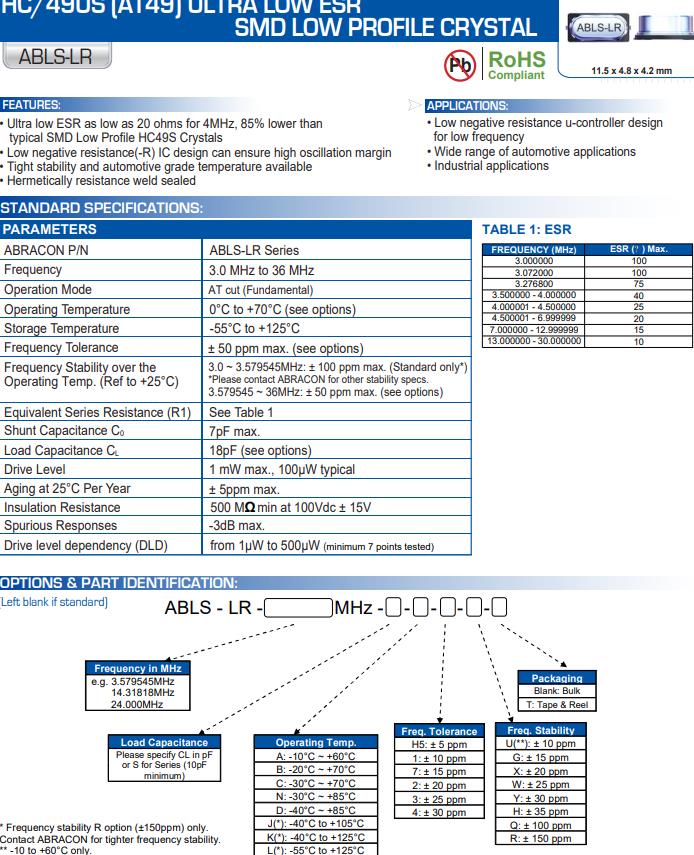为何这款无源晶振ABLS-LR-24.000MHZ-T能得到无线模块的青睐?
为何这款无源晶振ABLS-LR-24.000MHZ-T能得到无线模块的青睐?There are four main sources of heat generation from inductor losses when operating in an application.
They can be categorized into two groups referred to as copper losses and core losses.
1. Copper losses – these are losses primarily due to the inherent DC resistance (DCR) of the inductor’s wire. The wire has a known DC resistance which is a function of the wire length and the cross-sectional area of the wire (aka gauge). The DCR parameter can be found in all the Abracon inductor’s datasheets.
The power dissipated from the effects of the DCR are:
There is, however, a frequency component to copper loss due to what is called the skin effect and
proximity effect. The skin effect is where the electrons traveling through a conductor’s magnetic field are forced towards the outside ‘skin’ of the wire. As frequency increases, the skin effect strengthens causing AC resistance to increase.
The proximity effect further reduces current (increases resistance) due to magnetic fields of adjacent wires within the coil. Inductor coils with more turns and tightly packed windings will be affected greater by the proximity effect. Power dissipation from these AC effects is calculated by taking the RMS value of only the change in current seen by the inductor (sometimes called ripple current), squaring the RMS value and multiplying by the equivalent AC resistance.
AC resistance (ACR) is a difficult parameter to document due to its dependency on so many factors.
Abracon suggests that designers use an empirical method of measuring the copper loss from AC sources like the skin and proximity effects.
在应用中运行时,电感损耗产生的热量主要有四种来源。
它们可以分为两类,称为铜损失和芯损失。
1. 铜损耗——这些损耗主要是由于电感导线的固有直流电阻(DCR)造成的。导线有一个已知的直流电阻,它是导线长度和导线截面积的函数(又称量规)。而石英晶振低损耗恰好能够填补,DCR参数可以在所有Abracon电感器的数据表中找到。
为何这款无源晶振ABLS-LR-24.000MHZ-T能得到无线模块的青睐?交流电阻(ACR)是一个难以记录的参数,因为它依赖于如此多的因素。Abracon建议设计师使用经验方法来测量来自交流电的铜损失,如皮肤和邻近效应。随着市场对于石英晶体谐振器的参数要求增加,优化了许多优质的产品线。
They can be categorized into two groups referred to as copper losses and core losses.
1. Copper losses – these are losses primarily due to the inherent DC resistance (DCR) of the inductor’s wire. The wire has a known DC resistance which is a function of the wire length and the cross-sectional area of the wire (aka gauge). The DCR parameter can be found in all the Abracon inductor’s datasheets.
The power dissipated from the effects of the DCR are:
There is, however, a frequency component to copper loss due to what is called the skin effect and
proximity effect. The skin effect is where the electrons traveling through a conductor’s magnetic field are forced towards the outside ‘skin’ of the wire. As frequency increases, the skin effect strengthens causing AC resistance to increase.
The proximity effect further reduces current (increases resistance) due to magnetic fields of adjacent wires within the coil. Inductor coils with more turns and tightly packed windings will be affected greater by the proximity effect. Power dissipation from these AC effects is calculated by taking the RMS value of only the change in current seen by the inductor (sometimes called ripple current), squaring the RMS value and multiplying by the equivalent AC resistance.
AC resistance (ACR) is a difficult parameter to document due to its dependency on so many factors.
Abracon suggests that designers use an empirical method of measuring the copper loss from AC sources like the skin and proximity effects.
在应用中运行时,电感损耗产生的热量主要有四种来源。
它们可以分为两类,称为铜损失和芯损失。
1. 铜损耗——这些损耗主要是由于电感导线的固有直流电阻(DCR)造成的。导线有一个已知的直流电阻,它是导线长度和导线截面积的函数(又称量规)。而石英晶振低损耗恰好能够填补,DCR参数可以在所有Abracon电感器的数据表中找到。
从DCR的效果中耗散的能量是:
然而,由于所谓的蒙皮效应和铜损耗有一个频率成分邻近效应。蒙皮效应是指电子通过导体的磁场时被强迫向导线的外部“蒙皮”移动。无源晶振的频率有效增加,随着频率的增加,蒙皮效应增强,导致交流电阻增加。由于线圈内相邻导线的磁场,邻近效应进一步减少电流(增加电阻)。线圈匝数多、缠绕紧密的电感线圈受接近效应的影响较大。这些交流效应的功耗是通过取电感看到的电流变化的有效值(有时称为纹波电流),平方有效值并乘以等效的交流电阻来计算的。
| Manufacturer Part Number 原厂编码 | Manufacturer厂家 | Series型号 | Type 系列 | Frequency频率 | Package / Case包装/封装 |
| ABLS-LR-20.000MHZ-T | Abracon晶振 | ABLS-LR | MHz Crystal | 20MHz | HC49/US |
| ABM10-19.200MHZ-E20-T | Abracon晶振 | ABM10 | MHz Crystal | 19.2MHz | 4-SMD, No Lead |
| ABLS-LR-16.000MHZ-T | Abracon晶振 | ABLS-LR | MHz Crystal | 16MHz | HC49/US |
| ABM10-16.3676MHZ-E20-T | Abracon晶振 | ABM10 | MHz Crystal | 16.3676MHz | 4-SMD, No Lead |
| ABLS-LR-6.7458MHZ-T | Abracon晶振 | ABLS-LR | MHz Crystal | 6.7458MHz | HC49/US |
| ABLS-LR-8.000MHZ-T | Abracon晶振 | ABLS-LR | MHz Crystal | 8MHz | HC49/US |
| ABLS-LR-5.000MHZ-T | Abracon晶振 | ABLS-LR | MHz Crystal | 5MHz | HC49/US |
| ABLS-LR-3.579545MHZ-T | Abracon晶振 | ABLS-LR | MHz Crystal | 3.579545MHz | HC49/US |
| ABLS-LR-24.000MHZ-T | Abracon晶振 | ABLS-LR | MHz Crystal | 24MHz | HC49/US |
| ABLS-LR-4.000MHZ-T | Abracon晶振 | ABLS-LR | MHz Crystal | 4MHz | HC49/US |
| ABLS-LR-9.8304MHZ-T | Abracon晶振 | ABLS-LR | MHz Crystal | 9.8304MHz | HC49/US |
| ABLS-LR-10.000MHZ-T | Abracon晶振 | ABLS-LR | MHz Crystal | 10MHz | HC49/US |
| ABLS-LR-12.000MHZ-T | Abracon晶振 | ABLS-LR | MHz Crystal | 12MHz | HC49/US |
“推荐阅读”
相关行业资讯
- 晶振中的精密典范丹麦格耶KX-12B的领先技术
- 美国Greenray晶振N623的VCXO卓越性能与广泛应用
- 计时器件是数字电子产品的心脏
- SiTime定时简化电源问题并确保信号完整性
- MTI-milliren米利伦晶振公司数据手册
- Rubyquartz卢柏R2016-40.000-10-2050-TR晶体产品应用程序
- Crystek新产品CVCO55CC-1630-1630压控振荡器专用于卫星通信系统
- VTC石英晶体SM5B-20-C-30-30-F-24.000MHz型号参考列表详情
- Fortiming晶振XCS42-20M000-1C25B9频率控制产品系列
- Micro新型TS-3032-C7TAQA数字温度传感器模块应用
 手机版
手机版




 添加微信
添加微信


